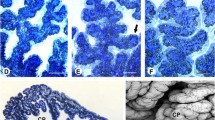Summary
Ciliary development was studied in the cells of the neural canal of chick embryos incubated from 60 hours to 7 days.
It was found that centrioles move after the last mitosis to the cell periphery where one of them enters into contact (terminal contact) with the cell membrane; the other centriole remains close by, its axis aligned along the axis of the former.
The cell membrane was seen afterwards bulging at the contact point, and the content of the ciliary bud thus formed is only constituted at the beginning of a varied number of vesicles of about 140 Å diameter.
The ciliary bud becomes elongated shortly after filaments start becoming organized in the bud matrix.
Roughly coinciding with the initiation of filament organization the centrioles move inward and the cilium becomes deeply invaginated in the cell. At the end of ciliary growth the centriole moves again toward the surface and the cilium emerges in the neural canal lumen.
Similar content being viewed by others
References
Bargmann, W.: Der Saccus Vasculosus. In: Progress in Neurobiology (Proceedings of the First Internat. Meeting of Neurobiologists), pp. 110–112. Groningen 1955.
Bargmann, W., u. A. Knoop: Elektronenmikroskopische Untersuchung der Krönchenzellen des Saccus vasculosus. Z. Zellforsch. 43, 184–194 (1955).
Bernhard, W., et E. de Harven: Sur la présence dans certains cellules de mammifères d'un organite de nature probablement centriolaire. Étude au microscope électronique. C. R. Acad. Sci. (Paris) 242, 288–290 (1956).
Duncan, D.: An elctron microscope study of the embryonic neural tube and Notochord. Tex. Rep. Biol. Med. 15, 367–377 (1957).
Fawcett, D. N., and K. R. Porter: A study of the fine structure of ciliated epithelia. J. Morph. 94, 221–282 (1954).
Harven, E. De, et W. Bernhard: Étude au microscope electronique de l'ultrastructure du centriole chez les vertébrés. Z. Zellforsch. 45, 378–398 (1956).
Heidenhain, M.: Plasma und Zelle, S. 284 bis 294. Jena: Gustav Fischer 1907.
Porter, K. R.: The submicroscopic morphology of protoplasm. Harvey Lect. 1957, 175–227.
Sotelo, J. R., and O. Trujillo-Cenóz: Electron microscope study of the kinetic apparatus in animal sperm cells. Z. Zellforsch. 1958 (in Druck).
Wilson, E. B.: The cell in development and heredity, 3. edit., p. 357–381. New York: MacMillan & Co. 1953.
Author information
Authors and Affiliations
Rights and permissions
About this article
Cite this article
Sotelo, J.R., Trujillo-Cenóz, O. Electron microscope study on the development of ciliary components of the neural epithelium of the chick embryo. Z. Zellforsch. 49, 1–12 (1958). https://doi.org/10.1007/BF00335059
Received:
Issue Date:
DOI: https://doi.org/10.1007/BF00335059




